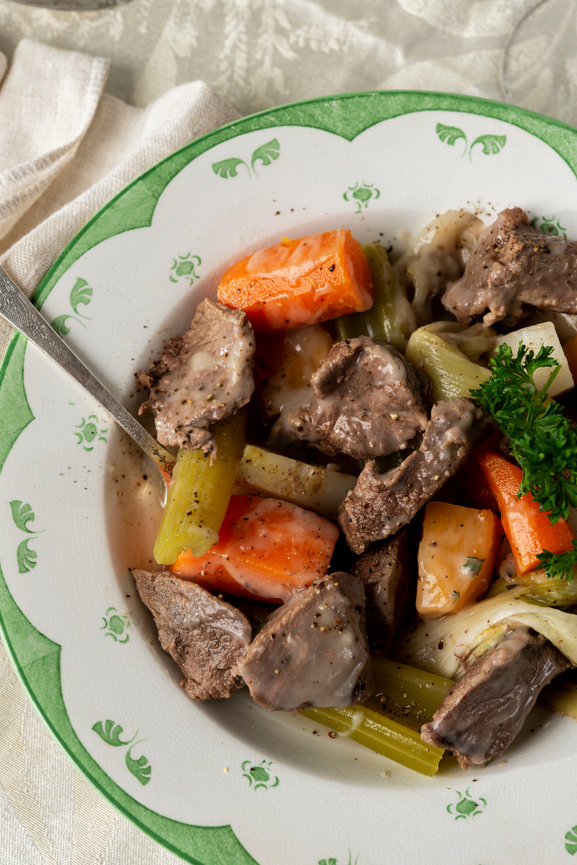Roast Chicken , au Jus
Friday, September 16, 2016 | By: Becky Diamond
This delicious recipe is directly adapted from a delightful cookbook called Handbook of Practical Cookery (1868) by French chef Pierre Blot. Although it dates back to the nineteenth century, it is easily modified for modern kitchens. Adding a little water to the pan steams the chicken at first, creating a moist interior. Removing the foil or lid toward the end of the cooking time allows the outside to get crispy and turn a nice caramel color.
Who was Pierre Blot?
Pierre Blot was a charismatic French chef who arrived in New York City in the mid 1900s. He saw the opportunity for a French cooking school, but realized he needed to fine-tune his English, so he initially worked as a French teacher in New York Schools and private homes. By 1865 he had taken advantage of New York’s burgeoning role as a gastronomic center by opening the New York Cooking Academy at 90 Fourth Avenue.
The inaugural class was launched with much fanfare and well reported in New York newspapers. The menu included the chicken au jus recipe featured below, as well as pot au feu (a beef and vegetable soup); striped bass with Hollandaise sauce; filet of mutton, larded and braised; spinach à la crème; turnips (as a garniture for boiled beef); and Genoise cake with almonds. Quite an enterprising agenda for one afternoon.
The New York Times reporter who sat in on Blot’s first lesson was particularly intrigued by the au jus technique for preparing roast chicken, calling it “entirely different from the ordinary method, as in fact were nearly all the professor's proceedings.” While Blot described the au jus methodology (a meat dish dressed with its own juices or gravy), his skilled female assistant deftly trimmed, cleaned and “trussed” the chicken, placing it in two pans, one inside the other, the larger containing some water. She then covered the chicken with buttered paper, carefully making sure it extended beyond the edges of the pan. The professor explained that this protective covering prevented the oven’s intense heat from scorching the meat, and helped catch and hold the steam that rose from the bottom pan, ensuring that it was continually basted and cooked “beautifully almost without care.” Think of it as a nineteenth century version of an oven “steamer bag.”
Pierre Blot was such a fascinating culinary trailblazer that I have decided to make him the subject of my next book. As I work on adapting some of his recipes, I have enlisted some foodie friends to help with the testing process. So far the feedback has been overwhelmingly positive! My friend Maureen claimed that the chicken was probably the best she’d ever made, noting that the butter made a big difference. She usually uses olive oil instead of butter for basting, but will definitely use butter for roasting from now on. She also went a little higher than the suggested 165 degrees for the internal temperature, but the chicken was still incredibly moist and flavorful. Another friend, Martha Sprowles, described the chicken as absolutely delicious – very juicy with a "buttery and wonderful" flavor. I also agree from my own experience making this dish that the end result is the best roast chicken ever - extremely moist and flavorful. Would love to get your take! Enjoy.
Roast Chicken, Au Jus
- One small chicken, about 3-5 pounds
- Salt
- Pepper
- 1 lemon
- 1 stick butter
- Preheat oven to 400°F. Season the chicken inside and out with salt, pepper and lemon juice. Add some lemon peel and a large lump of butter to the cavity. Rub generously with butter and place it on a rack inside a well-greased roasting pan.
- Wrap a buttered piece of parchment paper or aluminum foil around the chicken (or use a roasting pan with a lid). Add ½ cup water to pan.
- Bake for 45 minutes and then remove foil or lid and continue baking until juices run clear and a meat thermometer inserted into the thickest part of the breast and thigh reads 165°F, about 30-45 min. depending on the size of the chicken.
- Let rest for 15 minutes before carving. Serve with the roasting juices left in the pan, skimming off any surface fat.
Yield: 4 servings
Adapted from Handbook of Practical Cookery by Pierre Blot, 1868






Leave a comment
0 Comments